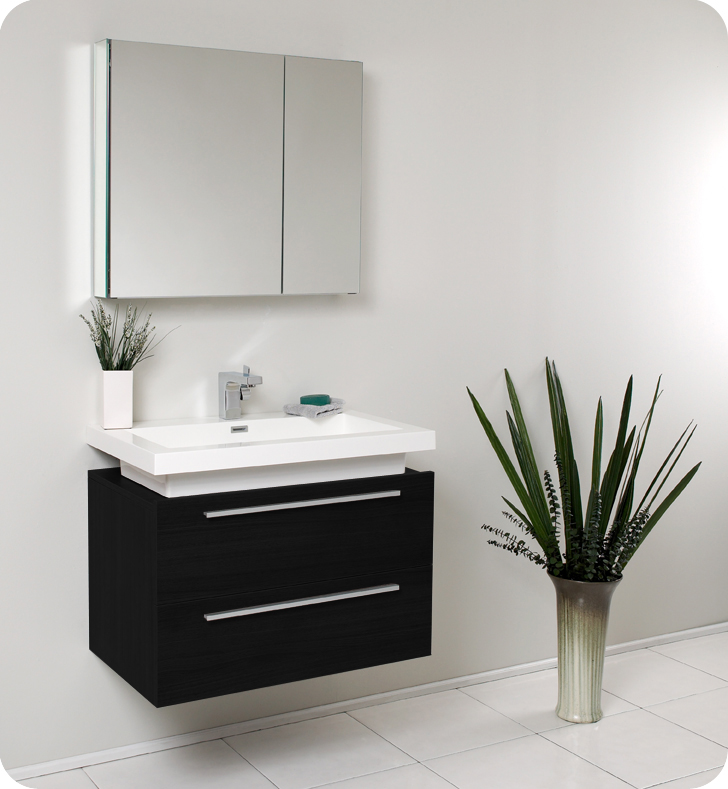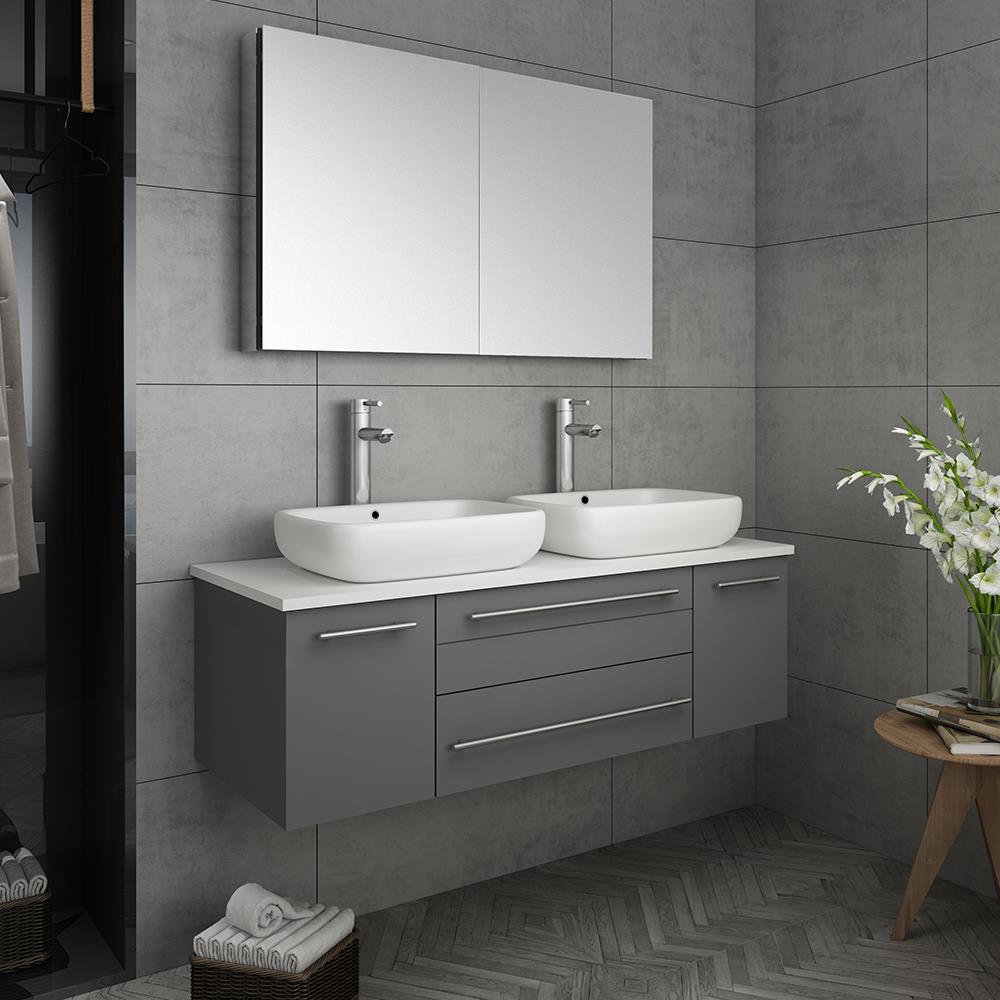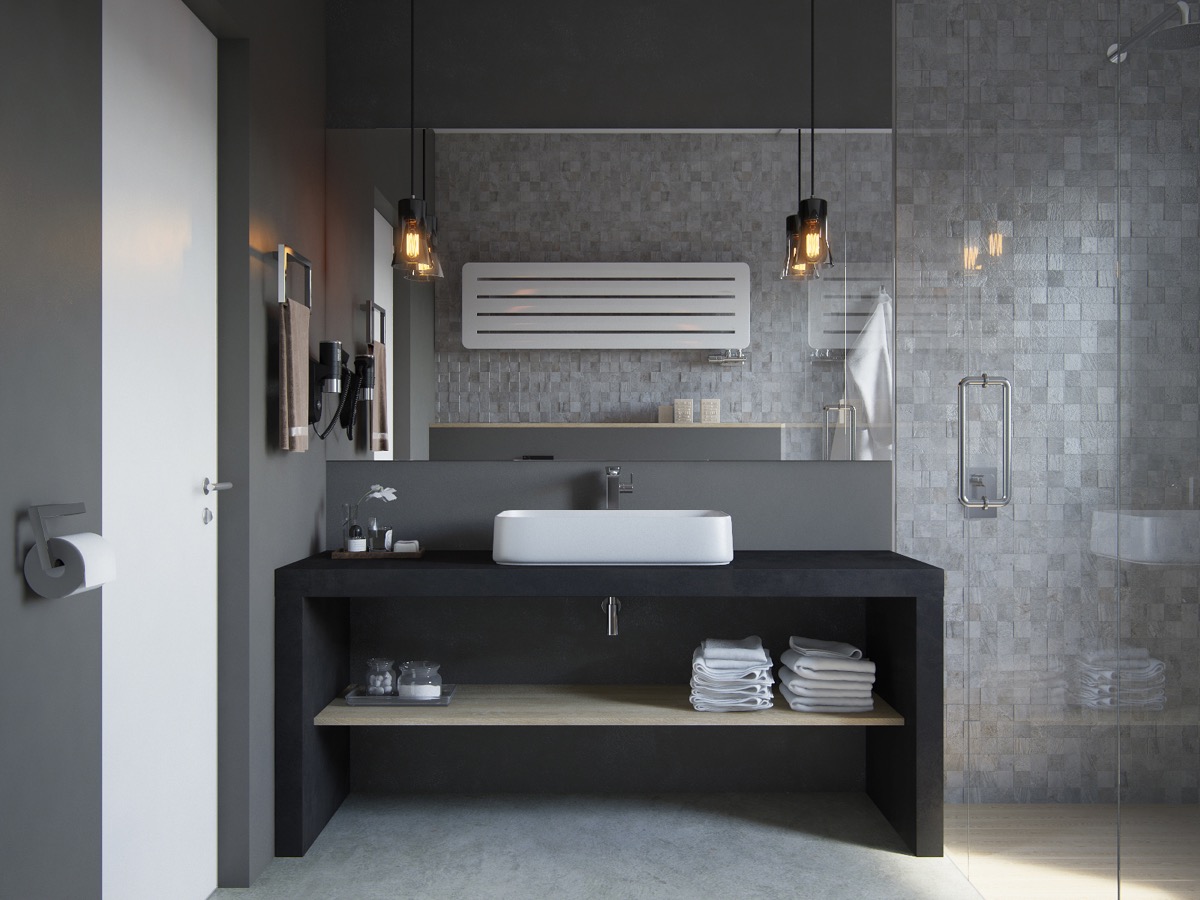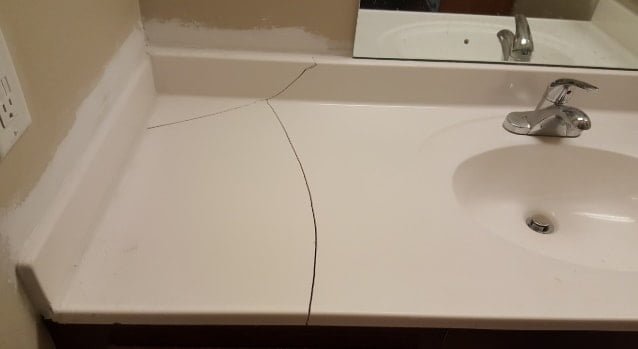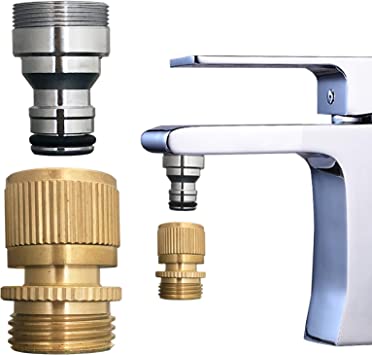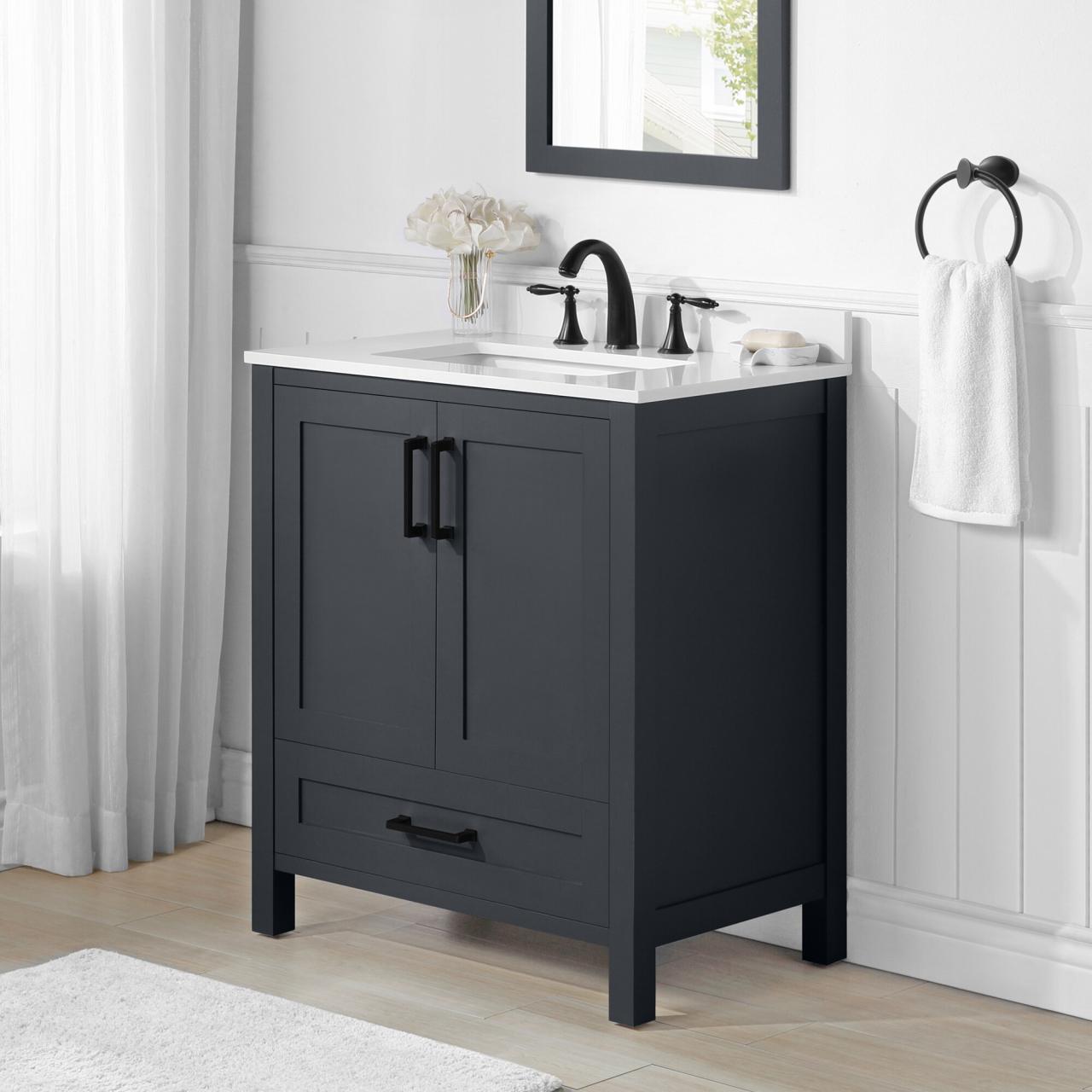The Evolution of Bathroom Vanities: From Classic to Contemporary
When I consider the bathroom vanity’s journey through history, I’m struck by how much this essential piece of bathroom furniture has evolved. What began as a simple, functional fixture has transformed into a key element of modern bathroom design, reflecting the cultural and aesthetic shifts of each era. Let’s take a closer look at the evolution of bathroom vanities, from their classic roots to the sleek, contemporary styles we see today.
- The Early Days: Basic and Functional The earliest bathroom vanities were nothing more than a simple table with a basin for washing. These pieces were functional and served a basic purpose, with little attention paid to design or aesthetics. Made from wood and often quite rustic, they were a far cry from the elegant vanities we know today.
- The Victorian Era: Ornate and Luxurious As indoor plumbing became more common in the 19th century, bathroom vanities started to become more elaborate. During the Victorian era, vanities were often made from rich, dark woods like mahogany and featured intricate carvings and embellishments. These vanities were a symbol of wealth and sophistication, reflecting the opulence of the time.
- The Art Deco Influence: Sleek and Geometric The early 20th century brought a dramatic shift in vanity design with the rise of the Art Deco movement. Vanities during this period were characterized by sleek lines, geometric shapes, and the use of new materials like chrome and glass. This era marked the beginning of the transition towards more modern, streamlined designs.
- Mid-Century Modern: Practical and Compact The mid-20th century saw the bathroom vanity become more compact and integrated into bathroom cabinetry. This period emphasized practicality and functionality, with a focus on making the most of available space. Materials like laminate became popular, making vanities more affordable and accessible to a wider audience.
- The Rise of Minimalism: Clean Lines and Simple Designs By the late 20th century, the minimalist movement had taken hold, and bathroom vanities reflected this trend. Contemporary vanities began to favor clean lines, simple designs, and a lack of ornamentation. The emphasis was on creating a serene, uncluttered space that felt both modern and timeless.
- The Contemporary Era: Innovative and Versatile Today, bathroom vanities are a true reflection of contemporary design. They combine innovative materials like quartz, concrete, and stainless steel with cutting-edge technology, offering features like integrated sinks, hidden storage, and customizable lighting. The variety of styles available means that there’s a contemporary vanity to suit every taste and space.
- Looking to the Future: Sustainable and Smart As we look to the future, the bathroom vanity continues to evolve, with a growing emphasis on sustainability and smart technology. Reclaimed materials, energy-efficient lighting, and smart mirrors are just a few of the innovations that are shaping the next generation of bathroom vanities.
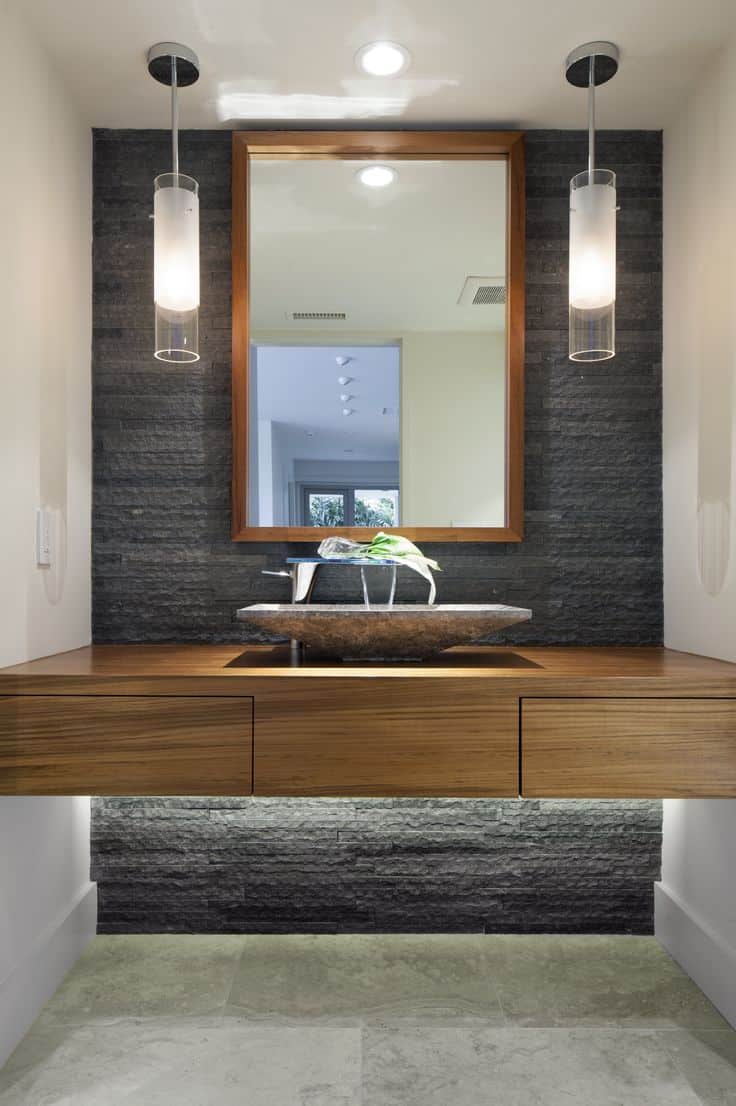
Key Features of Contemporary Bathroom Vanities
Contemporary bathroom vanities are more than just functional pieces of furniture; they are a key component of modern bathroom design. What sets these vanities apart are the features that define their sleek, minimalist aesthetic and enhance their practicality. Let’s explore the key features that make contemporary vanities so unique and desirable.
Minimalist Design: Clean Lines and Simplicity The hallmark of contemporary bathroom vanities is their minimalist design. Unlike traditional vanities, which often feature ornate details and heavy woodwork, contemporary vanities are all about clean lines and simplicity. This minimalist approach creates a sense of openness and tranquility, making the bathroom feel more spacious and serene.
Innovative Materials: Beyond Wood While wood remains a popular material, contemporary vanities often incorporate a variety of innovative materials such as glass, metal, and concrete. These materials contribute to the sleek, modern look of the vanity while offering practical benefits like durability and ease of maintenance. For example, glass countertops are easy to clean, and metal accents add a touch of industrial chic.
Smart Storage Solutions: Maximizing Space Adequate storage is essential in any bathroom, and contemporary vanities excel in this area with clever, space-saving solutions. Hidden drawers, pull-out shelves, and integrated organizers are common features, helping to keep the bathroom clutter-free. These storage solutions are particularly beneficial in small bathrooms, where maximizing space is crucial.
Integrated Lighting: Function Meets Aesthetics Lighting plays a significant role in contemporary vanity design. Many modern vanities feature integrated LED lighting, which not only enhances the aesthetic appeal but also provides functional illumination for tasks like shaving or applying makeup. Some designs even offer customizable lighting options, allowing you to adjust brightness and color temperature to suit your needs.
Functional Features: Ease of Use and Maintenance Contemporary vanities are designed with functionality in mind. Features like integrated sinks, soft-close drawers, and easy-to-clean surfaces make these vanities not only beautiful but also practical for everyday use. These thoughtful design elements contribute to a seamless bathroom experience, making your daily routine more enjoyable.
Versatility in Design: A Vanity for Every Space One of the most appealing aspects of contemporary bathroom vanities is their versatility. Whether you have a large, spacious bathroom or a compact powder room, there’s a contemporary vanity that will fit your needs. From wall-mounted designs that save space to freestanding models that make a bold statement, the options are endless.
Eco-Friendly Options: Sustainable and Stylish As sustainability becomes increasingly important, many contemporary vanities are designed with eco-friendly materials and practices in mind. Reclaimed wood, low-VOC finishes, and energy-efficient lighting are just a few of the ways that modern vanities are contributing to a more sustainable future.
Materials and Finishes That Define Modern Vanity Designs
The choice of materials and finishes can make or break a bathroom vanity design. In contemporary vanities, the use of innovative materials and high-quality finishes is what sets them apart and gives them their distinctive look. Here’s a closer look at the materials and finishes that define modern vanity designs.
Wood: Warmth and Natural Beauty Wood remains a staple in vanity design, but contemporary vanities often use it in new and exciting ways. Sleek veneers, reclaimed wood, and eco-friendly options are all popular choices, bringing warmth and natural beauty to the bathroom. The use of wood in minimalist designs creates a harmonious balance between nature and modernity.
Stone: Luxury and Durability Natural stone, such as marble, granite, and quartz, is a popular choice for contemporary vanity countertops. These materials add a touch of luxury and sophistication to the bathroom, while also offering durability and easy maintenance. The unique patterns and textures of natural stone create a sense of timeless elegance.
Glass: Sleek and Easy to Maintain Glass is often used in contemporary vanity designs for countertops, sinks, and shelving. Its sleek, reflective surface adds a modern, airy feel to the bathroom. Glass is also easy to clean and maintain, making it a practical choice for high-use areas. Frosted or textured glass can add an extra layer of interest to the design.
Metal: Industrial Edge Metal accents, such as stainless steel, brass, and blackened steel, bring an industrial edge to contemporary vanities. These materials are often used for hardware, frames, or even entire vanity structures. The finish can range from polished and reflective to matte and understated, allowing for a wide range of design possibilities.
Concrete: Modern and Unique Concrete is becoming increasingly popular in contemporary bathroom vanity design. Its raw, industrial look adds a unique, modern touch to the bathroom. Concrete can be molded into various shapes and sizes, making it a versatile material for both countertops and sinks. The finish can be polished for a sleek look or left rough for a more rustic appeal.
Composite Materials: Innovation and Versatility Composite materials, such as solid surface and engineered stone, offer a high level of versatility in modern vanity design. These materials can mimic the look of natural stone or wood while providing greater durability and ease of maintenance. They are available in a wide range of colors and finishes, allowing for endless customization options.
Eco-Friendly Finishes: Sustainable and Stylish As sustainability becomes a priority in home design, many contemporary vanities are finished with eco-friendly products. Low-VOC paints, water-based sealants, and sustainable sourcing practices ensure that your vanity is not only stylish but also environmentally responsible. These finishes contribute to a healthier indoor environment and a more sustainable future.
Choosing the Right Size and Style for Your Space
Selecting the perfect bathroom vanity is all about finding the right balance between size, style, and functionality. A vanity that’s too large can overwhelm the space, while one that’s too small may not provide enough storage or counter space. Here’s a guide to choosing the right size and style for your bathroom.
Assess Your Space: Measure Twice, Buy Once The first step in choosing the right vanity is to assess your bathroom’s size and layout. Measure the available space, taking into account the placement of doors, windows, and plumbing fixtures. Consider how much counter space you need and whether you require single or double sinks. Accurate measurements are crucial to ensure that the vanity fits perfectly in your bathroom.
Consider the Style: Traditional vs. Contemporary The style of your bathroom vanity should complement the overall design of your bathroom. If you have a traditional bathroom, you might opt for a vanity with classic details, like raised panel doors or ornate hardware. For a more contemporary look, choose a vanity with clean lines, minimalist hardware, and modern materials. The style you choose will set the tone for the entire bathroom.
Single vs. Double Vanity: Space and Functionality When choosing between a single and double vanity, consider both the size of your bathroom and your daily needs. A single vanity is ideal for smaller bathrooms or powder rooms, where space is limited. It provides sufficient counter space for one person and can make a small bathroom feel more open. A double vanity, on the other hand, is perfect for shared bathrooms or master suites, offering ample counter space and storage for two people.
Wall-Mounted vs. Freestanding: Maximizing Space Wall-mounted vanities are a popular choice in contemporary bathroom design, especially in smaller spaces. They create the illusion of more floor space and give the bathroom a sleek, modern look. Freestanding vanities, on the other hand, offer more storage and can serve as a statement piece in the bathroom. Consider the size of your bathroom and your storage needs when deciding between these two options.
Custom vs. Prefabricated: Tailoring to Your Needs While prefabricated vanities are readily available and often more affordable, a custom vanity allows you to tailor the size, style, and features to your exact needs. Custom vanities are ideal for bathrooms with unique layouts or specific design requirements. However, they can be more expensive and take longer to produce. Weigh the benefits of customization against your budget and timeline before making a decision.
Think About Storage: Drawers, Shelves, and Cabinets Storage is a key consideration when choosing a bathroom vanity. Consider how much storage space you need for toiletries, towels, and other bathroom essentials. Vanities with drawers, shelves, and cabinets offer different storage solutions, so think about what will work best for your needs. For example, deep drawers are ideal for storing larger items, while open shelves can keep frequently used items within easy reach.
Consider the Future: Flexibility and Adaptability As your needs may change over time, it’s important to choose a vanity that offers some flexibility. For example, opting for a vanity with adjustable shelves or modular components can allow you to reconfigure the storage as needed. Also, consider how the vanity might fit into future bathroom renovations or changes in your household. A versatile, timeless design can ensure that your vanity remains functional and stylish for years to come.
Innovative Storage Solutions in Contemporary Vanities
In contemporary bathroom design, maximizing storage is key, especially in smaller spaces. Modern vanities are designed with innovative storage solutions that help keep the bathroom organized and clutter-free. Here are some of the most effective storage ideas that you’ll find in contemporary vanities.
Hidden Drawers: Keeping Clutter Out of Sight One of the most popular storage solutions in contemporary vanities is the use of hidden drawers. These drawers are often integrated into the vanity’s design, offering a discreet place to store smaller items like toiletries, makeup, and grooming tools. The smooth, seamless appearance of the vanity is maintained, while the hidden storage keeps clutter out of sight.
Pull-Out Shelves: Easy Access to Essentials Pull-out shelves are another innovative storage feature that makes accessing your bathroom essentials easier. These shelves can be hidden behind cabinet doors and pulled out when needed, providing easy access to items stored at the back of the vanity. This is particularly useful for storing taller items like bottles or cleaning supplies, which can be difficult to reach in traditional cabinets.
Vertical Storage: Making the Most of Height Vertical storage is an excellent way to maximize space in a bathroom, especially in smaller areas. Contemporary vanities often incorporate tall cabinets or shelving units that extend upwards, providing additional storage without taking up valuable floor space. These vertical solutions are perfect for storing towels, linens, and other bulky items.
Integrated Organizers: Streamlining Your Routine Integrated organizers are a common feature in contemporary vanities, helping to keep everything in its place. These organizers can be built into drawers or cabinets and are designed to hold specific items like hairdryers, curling irons, and other grooming tools. By keeping everything organized and within reach, these features can streamline your morning routine.
Open Shelving: Display and Storage in One Open shelving is a popular trend in contemporary bathroom design, offering both storage and display space. These shelves can be used to store towels, decorative items, or frequently used products, making them easily accessible while adding a stylish touch to the bathroom. The open design also helps to create a sense of openness and space, which is especially beneficial in smaller bathrooms.
Vanity Towers: Extra Storage with Style Vanity towers are tall, narrow cabinets that can be added to either side of the vanity or mounted on the wall. They offer extra storage without taking up too much space and can be customized with shelves, drawers, or doors. Vanity towers are ideal for storing items like toiletries, makeup, and towels, and they can be designed to match the style of your vanity.
Under-Sink Storage: Making the Most of Every Inch The area under the sink is often underutilized in bathroom vanities, but contemporary designs have found ways to maximize this space. Pull-out trays, baskets, and customized shelving can be added to the under-sink area to store cleaning supplies, extra toiletries, or even small bins for waste and recycling. By making the most of this often-overlooked space, you can keep your bathroom organized and efficient.
Incorporating Technology: Smart Features in Modern Vanities
In today’s tech-savvy world, it’s no surprise that smart features are making their way into bathroom vanities. These innovations not only enhance the functionality of the vanity but also add a touch of luxury to your daily routine. Here’s a look at some of the most exciting smart features available in modern vanities.
Smart Mirrors: More Than Just a Reflection Smart mirrors are one of the most popular high-tech additions to contemporary bathroom vanities. These mirrors often come with built-in LED lighting, touch controls, and even Bluetooth connectivity. Some models can display the time, weather, and other information, while others offer integrated speakers for listening to music or taking calls while you get ready.
Integrated Charging Stations: Power Up Your Devices With the growing number of electronic devices we use daily, having a charging station in the bathroom can be incredibly convenient. Many modern vanities now come with integrated USB ports and electrical outlets, allowing you to charge your phone, tablet, or electric toothbrush right at the vanity. This feature helps keep your devices powered up and ready to go without cluttering the bathroom with cords.
Touchless Faucets: Hygienic and Convenient Touchless faucets, once reserved for commercial spaces, are now becoming a popular feature in residential bathrooms. These faucets use motion sensors to activate the water flow, reducing the spread of germs and making it easier to wash your hands or brush your teeth without touching the faucet. Some models also allow you to control the water temperature and flow with precision.
LED Lighting: Customizable and Energy-Efficient LED lighting has become a standard feature in many contemporary bathroom vanities, and for good reason. LEDs are energy-efficient, long-lasting, and provide excellent illumination for tasks like shaving or applying makeup. Some vanities offer customizable lighting options, allowing you to adjust the brightness and color temperature to create the perfect ambiance for your bathroom.
Heated Drawers: Keeping Towels Warm and Dry Heated drawers are a luxurious feature that can make your bathroom feel like a spa. These drawers are designed to keep towels warm and dry, so you can wrap yourself in a cozy, heated towel after your shower. Some models also include settings for drying delicate items or warming up your clothes on a cold day.
Built-In Speakers: Music at Your Fingertips If you enjoy listening to music while you get ready in the morning, a vanity with built-in speakers could be the perfect addition to your bathroom. These speakers are often integrated into the vanity or mirror and can connect to your phone or other devices via Bluetooth. This allows you to control your music, podcasts, or even take calls, all without leaving the bathroom.
Voice-Controlled Features: The Future of Bathroom Convenience As voice assistants like Amazon Alexa and Google Assistant become more integrated into our lives, they’re also making their way into bathroom vanities. Some modern vanities are now equipped with voice-controlled features, allowing you to adjust the lighting, play music, or even control the faucet with simple voice commands. This hands-free convenience adds a new level of luxury and ease to your bathroom experience.
Tips for Pairing Your Vanity with Other Bathroom Elements
Choosing the right bathroom vanity is only part of the design process. To create a cohesive and visually appealing bathroom, it’s important to consider how your vanity will pair with other elements in the space. Here are some tips for ensuring your vanity works harmoniously with the rest of your bathroom.
Coordinate Colors and Finishes: Create a Unified Look One of the easiest ways to create a cohesive bathroom design is by coordinating the colors and finishes of your vanity with other elements, such as the countertops, tiles, and fixtures. For example, if your vanity has a matte black finish, consider using the same finish for your faucet, showerhead, and cabinet hardware. Similarly, if you have a marble countertop, you might choose a vanity with a complementary wood tone.
Balance Proportions: Keep the Space in Harmony The proportions of your vanity should be in balance with the other elements in your bathroom. A large, freestanding vanity might overwhelm a small bathroom, while a tiny vanity could look out of place in a spacious master bath. Consider the size and scale of your vanity to the room’s dimensions, and choose other elements, such as mirrors, lighting, and storage, that are in proportion.
Consider the Style: Consistency is Key Your vanity’s style should align with the overall design theme of your bathroom. If you’re going for a modern, minimalist look, choose a vanity with clean lines and simple hardware. For a more traditional or classic bathroom, a vanity with detailed woodwork or a vintage-inspired design might be more appropriate. Consistency in style will create a seamless and harmonious bathroom environment.
Match the Lighting: Set the Right Mood Lighting plays a crucial role in the overall look and feel of your bathroom. When choosing lighting fixtures, consider how they will pair with your vanity. For example, if your vanity has a sleek, modern design, opt for contemporary light fixtures with clean lines and a similar finish. The right lighting can enhance the vanity’s appearance and create the perfect ambiance for your bathroom.
Think About Functionality: Form Meets Function While aesthetics are important, functionality should not be overlooked. Ensure that your vanity pairs well with other functional elements in the bathroom, such as the sink, faucet, and mirror. For example, if you have a wall-mounted faucet, you’ll need to choose a vanity and sink that work well with this configuration. Similarly, if you’re adding a large mirror, make sure it’s positioned at the right height for your vanity.
Incorporate Storage Solutions: Keep It Organized Storage is a key consideration in bathroom design, and your vanity should complement other storage solutions in the space. For example, if your vanity has limited storage, you might want to add a wall-mounted cabinet or open shelving to keep the bathroom organized. Consider how the vanity’s storage features will work with other elements, such as towel bars, hooks, and shelving, to create a well-organized space.
Don’t Forget the Details: The Finishing Touches The finishing touches can make all the difference in a bathroom’s design. Consider adding accessories, such as soap dispensers, trays, and decorative items, that complement your vanity and tie the whole look together. These small details can add personality and style to your bathroom, making it feel complete and cohesive.
Common Mistakes to Avoid
When designing a bathroom, it’s easy to make mistakes that can impact the overall look and functionality of the space. Here are some common mistakes to avoid when choosing and pairing your bathroom vanity.
Ignoring the Bathroom Layout One of the biggest mistakes is not considering the layout of your bathroom when choosing a vanity. Make sure the vanity fits comfortably within the space and doesn’t obstruct any doors, windows, or traffic flow.
Choosing the Wrong Size Selecting a vanity that’s too large or too small for your bathroom can throw off the balance of the space. Always measure your bathroom carefully and choose a vanity that’s proportionate to the room’s size.
Overlooking Storage Needs A vanity that doesn’t provide enough storage can lead to clutter and disorganization. Consider your storage needs and choose a vanity with enough drawers, shelves, and cabinets to keep your bathroom tidy.
Not Considering Plumbing The location of plumbing fixtures can limit your vanity options. Make sure the vanity you choose is compatible with your existing plumbing or be prepared for additional plumbing work.
Mismatching Styles A vanity that doesn’t match the style of the rest of your bathroom can create a disjointed look. Ensure that the vanity’s design, materials, and finishes complement the overall aesthetic of your bathroom.
Forgetting About Lighting Poor lighting can detract from the appearance and functionality of your vanity. Make sure your bathroom has adequate lighting, and consider adding task lighting around the vanity for better visibility.
What is the most popular material for contemporary bathroom vanities?
Wood, particularly in sleek veneers or eco-friendly options, remains a popular choice for contemporary bathroom vanities. However, materials like glass, metal, and composite materials are also widely used for their modern aesthetic and practical benefits.
How do I choose the right size vanity for a small bathroom?
In a small bathroom, it’s important to choose a vanity that doesn’t overwhelm the space. Opt for a compact, wall-mounted vanity that maximizes floor space while still providing adequate storage. Measure your bathroom carefully and consider the placement of doors and fixtures.
What are the benefits of a wall-mounted vanity?
Wall-mounted vanities are ideal for small bathrooms as they create the illusion of more space by leaving the floor visible. They also offer a sleek, modern look and can be installed at any height, making them customizable for different users.
Can I add smart features to an existing bathroom vanity?
Yes, many smart features, such as LED lighting, integrated charging stations, and smart mirrors, can be added to an existing vanity. However, some features, like touchless faucets, may require professional installation and adjustments to your plumbing.
What are some eco-friendly options for bathroom vanities?
Eco-friendly bathroom vanities often use sustainable materials like reclaimed wood, low-VOC finishes, and energy-efficient lighting. Choosing a vanity made from recycled or responsibly sourced materials can also contribute to a more sustainable bathroom design.
How can I ensure my bathroom vanity stays in style?
To ensure your bathroom vanity remains in style, opt for a timeless design with clean lines and high-quality materials. Avoid overly trendy features and instead focus on a versatile, neutral aesthetic that can adapt to changing design trends over time.
Modern Bathroom Vanities That Overflow With Style
Related Posts:


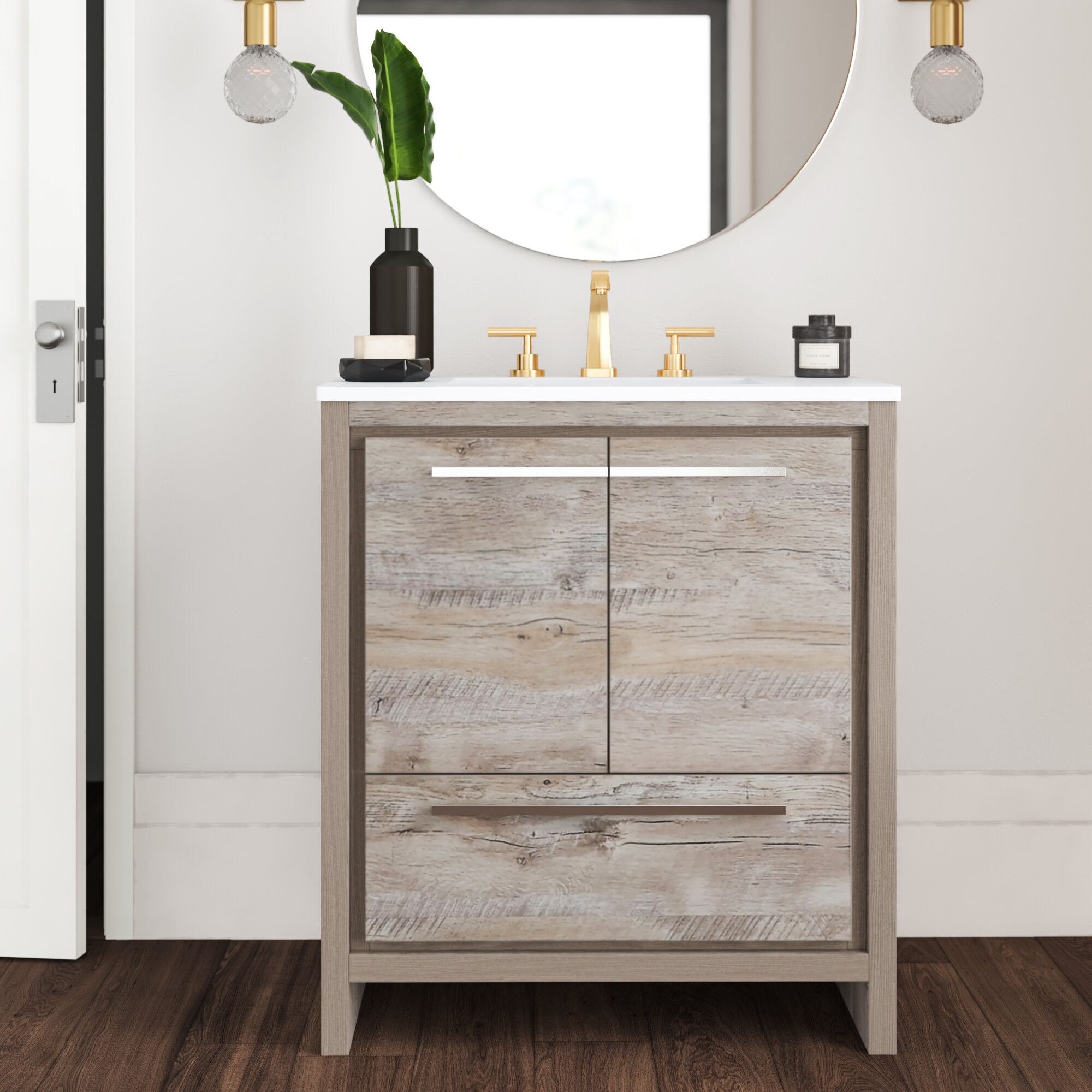

/mall/file/2021/06/03/8480a6033fda4f0b894d7c1a38fc6073.jpg)
